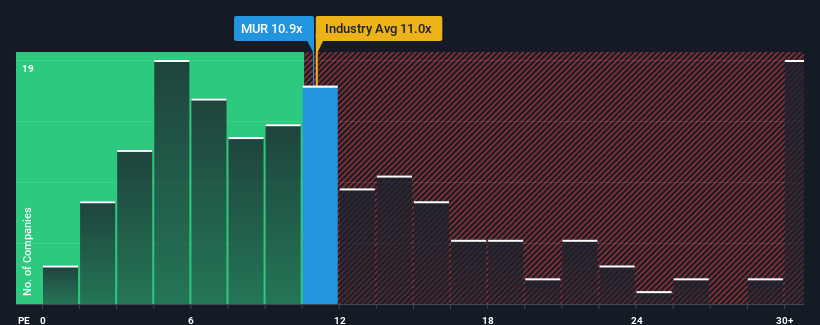
When close to half the companies in the United States have price-to-earnings ratios (or "P/E's") above 19x, you may consider Murphy Oil Corporation (NYSE:MUR) as an attractive investment with its 10.9x P/E ratio. Although, it's not wise to just take the P/E at face value as there may be an explanation why it's limited.
Recent times haven't been advantageous for Murphy Oil as its earnings have been falling quicker than most other companies. The P/E is probably low because investors think this poor earnings performance isn't going to improve at all. If you still like the company, you'd want its earnings trajectory to turn around before making any decisions. Or at the very least, you'd be hoping the earnings slide doesn't get any worse if your plan is to pick up some stock while it's out of favour.
See our latest analysis for Murphy Oil

Does Growth Match The Low P/E?
There's an inherent assumption that a company should underperform the market for P/E ratios like Murphy Oil's to be considered reasonable.
If we review the last year of earnings, dishearteningly the company's profits fell to the tune of 55%. At least EPS has managed not to go completely backwards from three years ago in aggregate, thanks to the earlier period of growth. So it appears to us that the company has had a mixed result in terms of growing earnings over that time.
Looking ahead now, EPS is anticipated to climb by 15% per year during the coming three years according to the eleven analysts following the company. That's shaping up to be materially higher than the 10% each year growth forecast for the broader market.
With this information, we find it odd that Murphy Oil is trading at a P/E lower than the market. Apparently some shareholders are doubtful of the forecasts and have been accepting significantly lower selling prices.
The Bottom Line On Murphy Oil's P/E
Using the price-to-earnings ratio alone to determine if you should sell your stock isn't sensible, however it can be a practical guide to the company's future prospects.
Our examination of Murphy Oil's analyst forecasts revealed that its superior earnings outlook isn't contributing to its P/E anywhere near as much as we would have predicted. When we see a strong earnings outlook with faster-than-market growth, we assume potential risks are what might be placing significant pressure on the P/E ratio. It appears many are indeed anticipating earnings instability, because these conditions should normally provide a boost to the share price.
Having said that, be aware Murphy Oil is showing 2 warning signs in our investment analysis, you should know about.
If these risks are making you reconsider your opinion on Murphy Oil, explore our interactive list of high quality stocks to get an idea of what else is out there.
If you're looking to trade Murphy Oil, open an account with the lowest-cost platform trusted by professionals, Interactive Brokers.
With clients in over 200 countries and territories, and access to 160 markets, IBKR lets you trade stocks, options, futures, forex, bonds and funds from a single integrated account.
Enjoy no hidden fees, no account minimums, and FX conversion rates as low as 0.03%, far better than what most brokers offer.
Sponsored ContentNew: Manage All Your Stock Portfolios in One Place
We've created the ultimate portfolio companion for stock investors, and it's free.
• Connect an unlimited number of Portfolios and see your total in one currency
• Be alerted to new Warning Signs or Risks via email or mobile
• Track the Fair Value of your stocks
Have feedback on this article? Concerned about the content? Get in touch with us directly. Alternatively, email editorial-team (at) simplywallst.com.
This article by Simply Wall St is general in nature. We provide commentary based on historical data and analyst forecasts only using an unbiased methodology and our articles are not intended to be financial advice. It does not constitute a recommendation to buy or sell any stock, and does not take account of your objectives, or your financial situation. We aim to bring you long-term focused analysis driven by fundamental data. Note that our analysis may not factor in the latest price-sensitive company announcements or qualitative material. Simply Wall St has no position in any stocks mentioned.
Have feedback on this article? Concerned about the content? Get in touch with us directly. Alternatively, email editorial-team@simplywallst.com
About NYSE:MUR
Murphy Oil
Operates as an oil and gas exploration and production company in the United States, Canada, and internationally.
Very undervalued established dividend payer.


